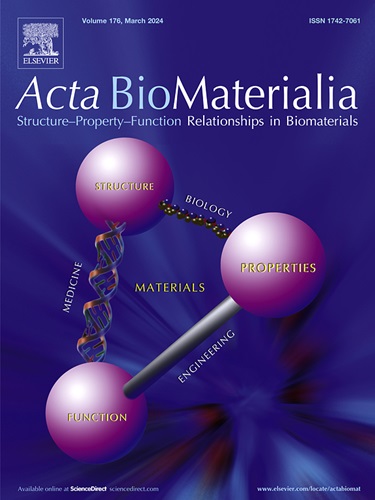Regulation of the gelatin helix-to-coil transition through chain confinements at the polymer-protein interface and protein-protein interface
IF 9.6
1区 医学
Q1 ENGINEERING, BIOMEDICAL
引用次数: 0
Abstract
Gelatin is an essential material widely used in biomedical applications due to its characteristic temperature responsivity—helix-to-coil transition. However, the current helix-to-coil transition is limited by its single-step behavior and the difficulty in designing a specific onset temperature. In this study, we investigated the fundamentals of the helix-to-coil transition with a focus on gelatin chain mobility. We observed distinctive kinetics of the helix-to-coil transition, which is resilient and can actuate in multiple steps or with a controllable onset point. This was achieved by confining the gelatin chain with a hydrophilic polymer or gelatin itself. The confinement approach serves two purposes: first, it prevents excessive mobility of the generated coils, maintaining physical resilience after the helix-to-coil transition; second, the interfacial confinement between the polymer and gelatin, referred to as polymer-protein interface confinement, restricts the helix-to-coil transition, resulting in a multistep transition process. Additionally, strong confinement at the interface between gelatins of different origins, that is protein-protein interface confinement, shifts the onset temperature to a higher point. This fundamental comprehension of helix-to-coil transition could contribute to broadening the biomedical application potential of gelatin materials.
Statement of significance
Gelatin is essential in biomedical applications due to its characteristic temperature responsivity—helix-to-coil transition. Herein, we fundamentally investigated the distinctive kinetics of the helix-to-coil transition, which is resilient and can actuate in multiple steps or with a controllable onset point. This was achieved by confining the gelatin chain with a hydrophilic polymer or gelatin itself. The gelatin chain confinement prevents excessive mobility of the generated coils, maintaining physical resilience after the helix-to-coil transition. The interfacial confinement between the polymer and gelatin restricts the helix-to-coil transition, resulting in a multistep transition process. Additionally, strong confinement at the interface between gelatins of different origins shifts the onset temperature to a higher point.

在聚合物-蛋白质界面和蛋白质-蛋白质界面通过链约束调控明胶螺旋到线圈的转变。
明胶是一种重要的材料,广泛应用于生物医学应用,由于其特有的温度响应-螺旋到线圈的转变。然而,目前螺旋到线圈的转变受到其单步行为和设计特定起始温度的困难的限制。在这项研究中,我们研究了螺旋到线圈过渡的基本原理,重点是明胶链的流动性。我们观察到螺旋到线圈转变的独特动力学,它具有弹性,可以在多个步骤中启动或具有可控的起始点。这是通过用亲水性聚合物或明胶本身来限制明胶链来实现的。约束方法有两个目的:首先,它可以防止产生的线圈过度移动,保持螺旋到线圈转换后的物理弹性;其次,聚合物和明胶之间的界面约束,称为聚合物-蛋白质界面约束,限制了螺旋到线圈的转变,导致了多步骤的转变过程。此外,在不同来源的明胶之间的界面上的强约束,即蛋白质-蛋白质界面约束,使起始温度升高到更高的点。这种对螺旋到线圈转变的基本理解有助于扩大明胶材料的生物医学应用潜力。重要性声明:明胶在生物医学应用中是必不可少的,因为它的特征温度响应-螺旋到线圈的转变。在此,我们从根本上研究了螺旋到线圈转变的独特动力学,该转变具有弹性,可以在多个步骤中启动或具有可控的起始点。这是通过用亲水性聚合物或明胶本身来限制明胶链来实现的。明胶链约束防止产生线圈的过度流动性,保持螺旋到线圈过渡后的物理弹性。聚合物和明胶之间的界面约束限制了螺旋到线圈的转变,导致多步转变过程。此外,在不同来源的明胶之间的界面处,强约束将起始温度转移到更高的点。
本文章由计算机程序翻译,如有差异,请以英文原文为准。
求助全文
约1分钟内获得全文
求助全文
来源期刊

Acta Biomaterialia
工程技术-材料科学:生物材料
CiteScore
16.80
自引率
3.10%
发文量
776
审稿时长
30 days
期刊介绍:
Acta Biomaterialia is a monthly peer-reviewed scientific journal published by Elsevier. The journal was established in January 2005. The editor-in-chief is W.R. Wagner (University of Pittsburgh). The journal covers research in biomaterials science, including the interrelationship of biomaterial structure and function from macroscale to nanoscale. Topical coverage includes biomedical and biocompatible materials.
 求助内容:
求助内容: 应助结果提醒方式:
应助结果提醒方式:


